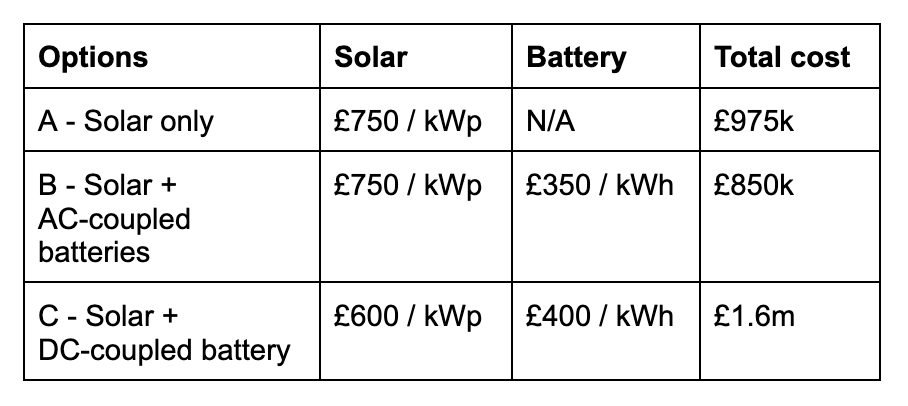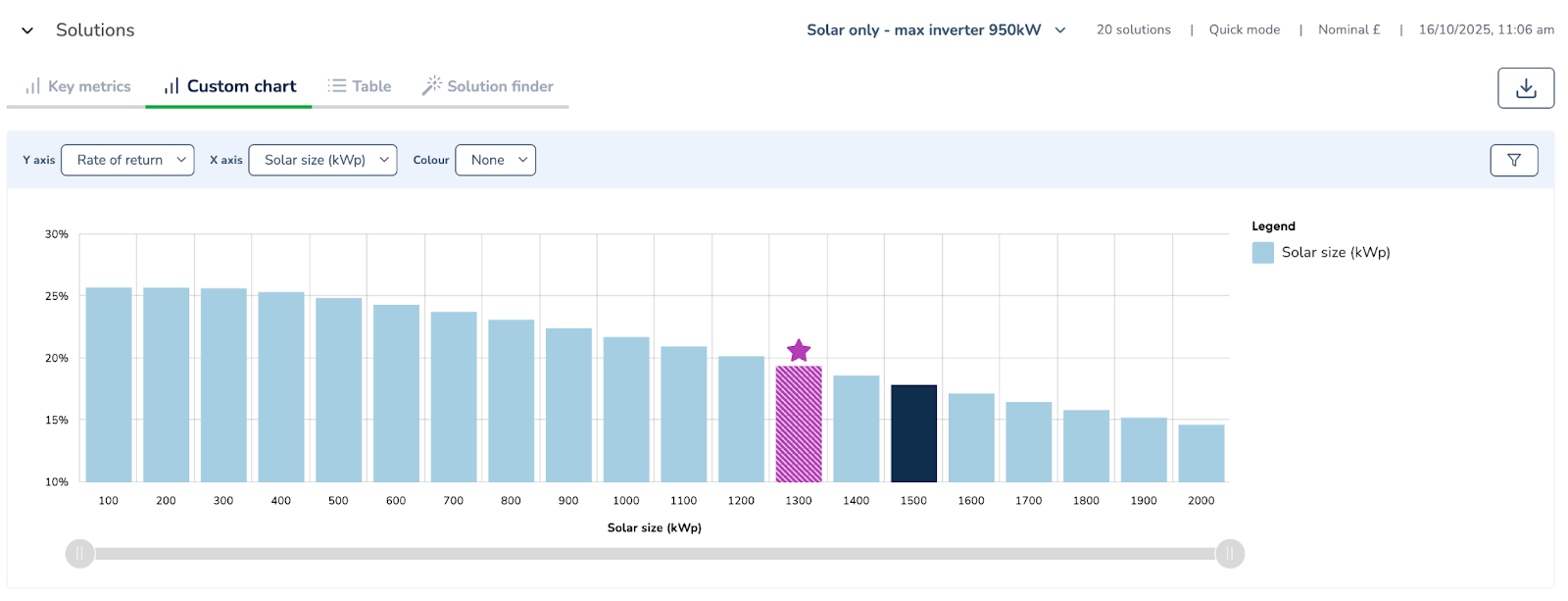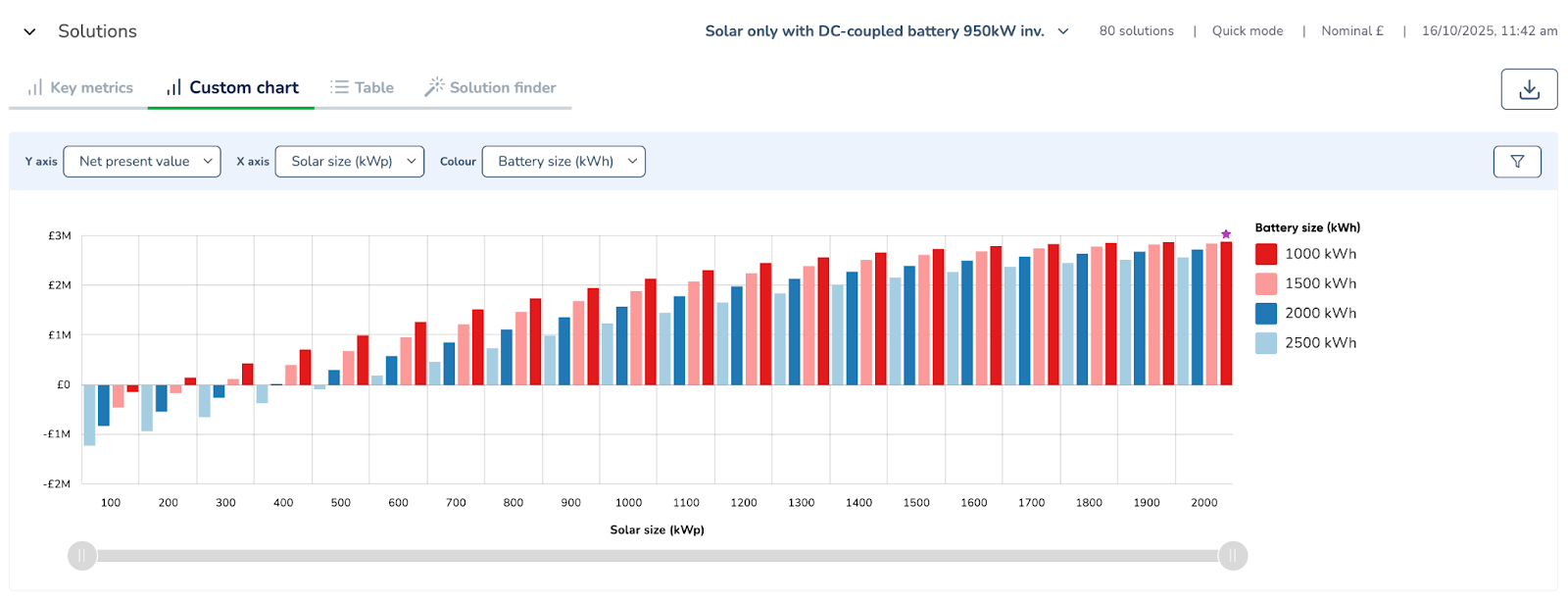Blog /
Industry Insights
High Voltage, Low Losses: Why going from AC to DC-coupled batteries rocks
October 29, 2025
.png)
For those exploring DC Coupled Batteries (we salute you)
Over the past few years, there’s been a surge of new DC-coupled battery options coming into the market. Evolving from success in the residential and utility-scale market segments, DC-coupled commercial batteries are now in vogue.
At first glance, the value proposition seems straightforward - and compelling. With a DC-coupled system, you can buy less equipment and there are also clear efficiency benefits versus AC-coupled systems.
But many of the headline efficiency and cost-saving claims made in marketing material for DC-coupled batteries miss the bigger picture. The real value of DC-coupled batteries lies not in side-by-side comparisons with AC-coupled batteries but in enabling more solar (or other generation options) to be deployed as shown in the image above.
In this blog, we’ll unpack why DC coupling can be a powerful option, explore the scenarios where it truly shines, and clarify the drivers that actually matter when selecting between AC and DC-coupled battery systems.
*and you'll have to forgive us the AC/DC references. We're an Australian born company - how could we not?!
DC-Coupled Battery Benefits: Efficiency Beyond the Hardware
The most obvious advantage of a DC-coupled system is in the hardware. With just one inverter instead of two, projects require fewer components: less cabling, fewer inverter losses, and lower balance-of-system costs. This typically translates into both capital cost savings and simpler system design, reducing engineering and installation complexity.
But that’s just the starting point. In addition to those hardware advantages, DC coupling also delivers a series of efficiency and performance advantages that can make a meaningful difference to project performance.
Leading battery company AceOn identifies six key technical benefits that can be unlocked through DC-coupled architectures that they claim improve performance by up to 24%:
- Storage Round-Trip Efficiency - versus an AC-coupled battery, solar generation can flow directly into the DC-coupled battery without travelling through two inverters. Eliminating the DC->AC->DC conversions to charge the battery with solar will improve round-trip efficiency.
- Reduced Harvest Curtailment - In some AC-coupled setups, solar energy can be curtailed by the solar inverter before it ever reaches the battery. This could be due to inverter or export limits, or time-varying grid constraints imposed by grid operators. By moving energy directly from solar to storage on the DC bus, curtailment losses are avoided, increasing the usable energy captured.
- Better Mismatch Recovery - DC-coupled architectures can recover energy more effectively at the string level, particularly under partial shading or mismatch conditions. While this isn’t something typically modelled within Orkestra’s platform, it’s a real-world source of incremental gains.
- Low-Voltage Harvest - When the PV array is operating at low voltages, inverters can fail to activate, resulting in lost generation. DC-coupled storage allows the system to run at higher operating voltages, avoiding those low-voltage losses.
- Mitigating Degradation Effects - According to AceOn, DC coupling can help recover energy losses linked to PV cell degradation over time, potentially improving lifetime system performance by up to 10%.
And finally (*drum roll*)
- Clipped Energy Harvest - Now this is the big one. When the PV array output exceeds the inverter capacity (e.g. with a typical DC-to-AC ratio of 1.3), the excess is normally clipped and lost. DC coupling allows that excess generation to be captured and stored in the battery instead of wasted — effectively increasing the useful yield without upsizing the inverter. More on this coming up.

Among these, three performance advantages are directly modelled within the Orkestra platform:
- Storage round-trip efficiency
- Curtailment reduction
- Clipped energy harvest - where we see the biggest benefit
In our view, these are also the most impactful in real projects.
In the case study below, we will explore the co-location of a battery alongside a commercial solar system in a DC-coupled configuration. This case study demonstrates how developers can significantly increase the solar system size and capture energy that would otherwise be lost in an AC-coupled setup.
Case Study: Energiser Foods
To bring these concepts to life, let’s look at a practical example — a fictional manufacturing and warehousing site we’ve called Energiser Foods. It’s a typical commercial load profile and has the physical space to install up to 2 MW of rooftop solar. But, like many real-world sites in the UK, it faces grid connection constraints that fundamentally shape the project design.
The local Distribution Network Operator (DNO) has imposed:
- An export limit of 100 kW — anything above this must be curtailed by the inverter.
- A maximum inverter size of 950 kW to manage fault current issues, a common constraint in commercial-scale projects.
These restrictions mean that although the roof can host a 2 MW solar system, the inverter must be sized at 950 kW, resulting in a DC-to-AC ratio of 2.2 if fully built out — far above the more typical 1.3 ratio usually accepted in design.
Energiser Foods’ main driver is maximising energy independence to reduce grid exposure, lower costs, and cut carbon emissions. To explore how best to achieve that, we modelled three system configurations with the following cost assumptions:

Option A: Solar Only
Solar Size: 1.3 MWp
Inverter: 950 kW
Energy Independence: 29.4%
Payback Period: 6.1 years
Initial Rate of Return (IRR): 19.4%
Starting with solar alone, we modelled scenarios from 100 kW up to 2 MW. We found that once the system passed 1.3 MWp, IRRs fall to unacceptable levels due to inverter clipping, and by 1.6 MWp, NPVs start to decline as well. Selecting 1.3 MWp provides the optimal balance for a solar-only system under the inverter constraint.


Option B: Solar + AC-Coupled Battery
Solar Size: 900 kWp
Inverter: 700 kW
Battery: 500 kWh / 250 kW
Energy Independence: 24.6%
Payback Period: 5.9 years
IRR: 20%
The next step was to pair a modest 2-hour battery with an AC-coupled configuration. Despite the storage addition, energy independence fell to 24.6 %, even though payback improved slightly due to lower upfront cost.
This reflects a common challenge: with AC coupling, export and inverter constraints still limit how much solar and batteries can be installed and their limit the generation of the site.
Option C: Solar + DC-Coupled Battery
Solar Size: 2 MWp
Inverter: 950 kW
Battery: 1 MWh / 1 MW (1C)
Energy Independence: 40.6%
Payback Period: 6.8 years
IRR: 17.3%
Finally, we explored a DC-coupled configuration, designed to maximise solar utilisation. By co-locating a 1 MWh battery at a 1C charge/discharge rate directly on the DC bus, the system can capture clipped energy that would otherwise be lost.
Although the payback period is slightly longer, the energy independence jumps to over 40 %, and this setup delivers the highest NPV of all configurations considered. This approach allows the project to fully exploit the site’s available roof space without breaching export or inverter limits.

Our Conclusion: DC-coupled batteries unlock the most value by maximising solar deployment when faced with grid constraints and/or inverter limitations.
While cost savings and efficiency improvements are valuable, the real power of DC-coupled systems lies elsewhere.
The biggest benefit isn’t just shaving off a few percentage points of conversion losses — it’s the ability to work around inverter size limitations that are so common on real-world projects.
When a DNO caps the inverter capacity on a site, that typically locks in the maximum system size and the project’s economic ceiling. But with a DC-coupled solution, developers can install significantly more solar capacity without breaching those export or inverter limits — and that can transform the project economics.
For end customers, this means greater energy independence, more on-site generation, and reduced grid reliance. For solar installers and developers, it opens the door to larger project scopes and stronger commercial outcomes by pairing solar and storage together.
DC coupling is a powerful tool for unlocking constrained sites — turning limitations into opportunities to maximise solar deployment and value.
Keen to explore modelling a DC coupled battery solution in Orkestra for your next C&I project? Book a meeting with our team today to get started.
Get your 3 week free trial
Get started exploring energy project feasibility analysis and reporting. Sign up now - no credit card required.

